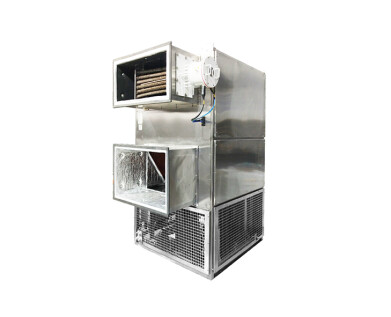Air monitoring
Hazardous area heating and ventilating air conditioning unit
Jul 17 2024
Approved Hazardous area HEATING AND VENTILATING AIR CONDITIONING UNIT are essential for controlling the temperature, humidity, and air quality of indoor environments. In industrial applications, these systems maintain precise conditions crucial for process and equipment reliability. Proper filtration and contaminant removal prevent hazardous gases from interfering with equipment function. Typically, standalone HVAC units range from 3 to 12 tons of cooling capacity and are certified for Zone 1 IIB + H2.
The Prodigy HVAC System offers several advantages. It enhances instrument accuracy by providing consistent environmental conditions, leading to more reliable data. Improved safety is achieved through proper ventilation, which prevents the buildup of hazardous gases. Human comfort is ensured with adequate cooling capacity, and the controlled environment extends the lifespan of equipment by reducing wear and tear.
Understanding your industrial requirements is vital before selecting an HVAC system. The size and layout of the analyser shelter significantly impact the type of HVAC system needed. Large spaces with high ceilings require different solutions than smaller, compartmentalised areas. Consider factors such as sun exposure, rain protection, the presence of corrosive gases, heat dissipation, and humidity to ensure complete air circulation, even in blind spots.
Temperature and humidity control are crucial in maintaining a comfortable environment and preventing hazardous air ingress. Proper heater selection is essential to avoid condensation. Pressure and volume control ensure clean air circulation and maintain hazardous gases within safe limits. Pressure indicators and alarms help prevent gas ingress and address any leaks that develop during operations.
A thorough HVAC system checklist includes assessing ambient temperature to determine specifications, regularly replacing filters to maintain air purity, and cleaning ducts and coils to ensure air quality and equipment efficiency. Routine inspections and maintenance help identify and address issues early, and manufacturers should provide mandatory training for HVAC systems. Timely servicing of critical components, such as compressors, coils, and fans, is necessary to prevent breakdowns, ensuring that only authorised personnel service Atex/IECEx products.
Selecting the right HVAC system for industrial applications is complex but essential. By understanding customer needs, prioritising energy efficiency, ensuring customisation, and committing to regular maintenance, an effective and sustainable HVAC system can be chosen. With 25 years of experience, Axis Solutions are experts in Atex HVAC systems, providing global solutions with comprehensive certifications.
Digital Edition
IET 35.2 March
April 2025
Air Monitoring - Probe Sampling in Hazardous Areas Under Extreme Conditions - New, Game-Changing Sensor for Methane Emissions - Blue Sky Thinking: a 50-year Retrospective on Technological Prog...
View all digital editions
Events
May 06 2025 Nuremberg, Germany
May 10 2025 Karachi, Pakistan
May 11 2025 Vienna, Austria
May 11 2025 Seoul, South Korea
Salon Analyse Industrielle & Instrumentation
May 14 2025 Paris, France







_(4427399123)-(2).jpg)











